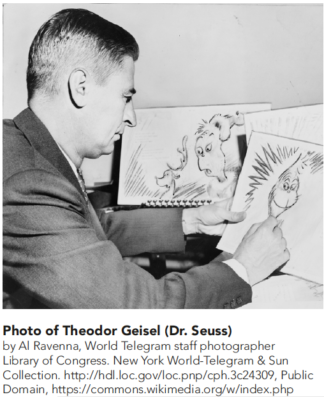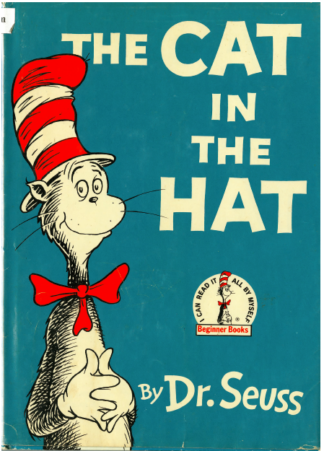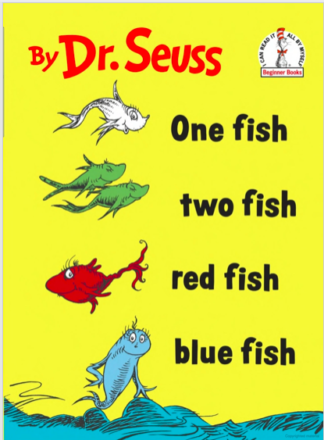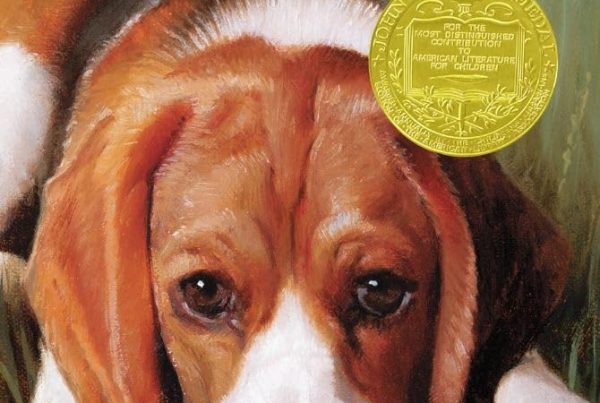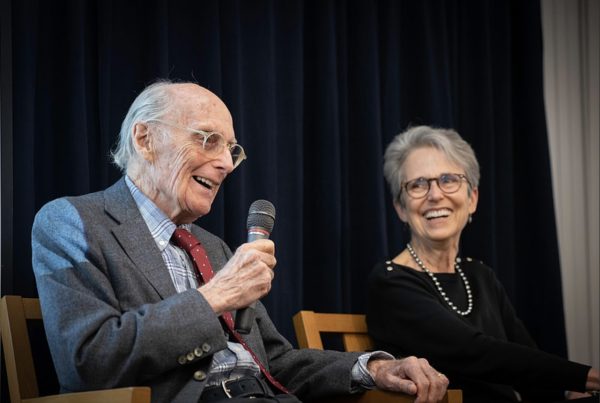Theodor Geisel AKA Dr. Seuss
In the words of Leonard S. Marcus
“Theodor S. Geisel—known as Dr. Seuss to his legions of sticky-fingered young fans—was a favorite picturebook author when a former army buddy turned publishing executive approached him with a daunting challenge. Starting from a list of about 300 “sight words” that five- and six-year-olds could be counted on to recognize, Seuss was asked to conjure a text capable of transforming America’s youngsters into readers for life.
The public enthusiastically embraced The Cat in the Hat as a winsome riposte to Dick-and-Jane-style monotony. The book’s popularity spawned not only a sequel but also a new publishing company—Beginner Books—with Seuss at the helm, and with P. D. Eastman and the Berenstains soon lending their talents as key contributors.”
The Cat in the Hat is on display in The ABC of It: Why Children’s Books Matter.
Things to Think About
There is a moving National Public Radio Story Corps piece about Maria Rivas who emigrated from El Salvador to the United States twenty years ago. If her temporary protected status visa expires she will be forced to leave the U.S. without her U.S.-born daughter Emily, a high-school freshman.
On January 11, 2019 NPR posted the daughter’s interview with her forty-year-old mother.
“Emily asks her mother what it was like for Maria to come to the U.S. in 2000, three years before she was born.
“I didn’t know [English] besides ‘good morning’ and ‘what’s your name?’ when I came here,” Maria says. “When you were baby, I used to read to you the Dr. Seuss books, like One Fish, Two Fish, Red Fish, Blue Fish. And that’s how I learned English, reading to you.”
This is just one of the many stories like the ones that we have been hearing families share about Dr. Seuss and the early readers that he wrote.
More To Think About
Interviewed for that episode were Katie Ishizuka and Ramón Stephens. They posit in their article, The Cat is Out of the Bag: Orientalism, Anti-Blackness and White Supremacy in Dr. Seuss that The Cat in the Hat, perhaps Seuss’ most famous character, was based on minstrel stereotypes.
(Some of those editorial cartoons can be viewed here.)
“The Cat’s physical appearance including the Cat’s oversized top hat, floppy bow tie, white gloves and frequently open mouth, mirrors actual blackface performers; as does the role he plays as ‘entertainer’ to the white family–in whose house he doesn’t belong.”
Katie Ishizuka and Ramón Stephens will be at the Elmer L. Andersen Library to discuss their research and findings on May 10th, 2019.
The ABC of It: Whose Story is Being Told?
Save the Date, May 10th, noon
The ABC of It: Whose Story is Being Told?
Race, Inclusion, and Representation in Children’s Literature
The ABC of It: Why Children’s Books Matter is an exhibit at the Elmer L. Andersen Library at the University of Minnesota Twin Cities Campus.
Join us on Friday, May 10, 2019, 12:00 Noon to 1:00 PM, Book signing to follow.
for an in-depth discussion of how all people who interact with children and books can examine bias, social justice, and literature, historically and today.
Panelists
Andrea Davis Pinkney, Vice President, Executive Editor- Scholastic Trade and New York Times bestselling author and Coretta Scott King Award Winner for Hand in Hand: Ten Black Men Who Changed America.
Dawn Quigley, PhD, Assistant Professor St. Catherine University, author of Silenced. Voices Taken from American Indian Characters in Children’s Literature and the young adult novel Apple in The Middle.
This event was made possible by generous gift from Governor Elmer L. and Mrs. Eleanor Andersen in honor of former University Librarian Dr. Edward B. Stanford.
Elmer L. Andersen Library, Room 120
University of Minnesota, 222 21st Ave. S., Minneapolis, MN 55455
Parking and directions Free and open to the public.
Light refreshments at 11:45 a.m.
RSVP HERE
.
Further Reading
As we think about children’s books and their place in our lives, education and culture there are scholars and teachers who give us insight. (Readings that informed the exhibit here )
This bibliography is on display on the 3rd and 2nd floor of the Andersen Library as well as copies of the articles lists. A PDF of the list here
Ishizuka, Katie and Stephens*, Ramon (2019) “The Cat is Out of the Bag: Orientalism, Anti-BIaclaiess, and White Supremacy in Dr. Seuss’s Children’s Books,” Research on Diversity in Youth Literature: Vol. l: Iss. 2 , Article 4. Available at: https://sophia.stkate.edu/rdyl/voll/iss2/4
Nel, P. (2001). “Said a bird m the midst of a blitz…”: How world war II created Dr. Seuss. Mosaic : A Journal for the Interdisciplinary Study of Literature, 34(2), 65-85. Retrieved from http://login.ezproxy.lib.umn.edu/login?url=https://search-proquestcom. ezp2.1ib.umn.edu/docview/20534l785?accountid= 14586
Nel, P. (2017). Was the cat in the hat black? New York: Oxford,University Press.

